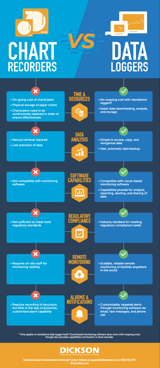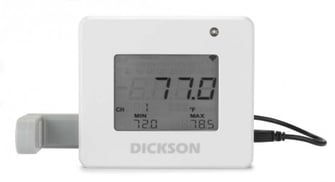There are essentially two types of devices used today for environmental monitoring and record-keeping: mechanical chart recorders and digital data loggers (DDLs). Chart recorders are, by far, the older technology, dating back about 100 years.
DDLs were first developed as a replacement for chart recorders, taking advantage of the revolution in microelectronics in the 1980s and 1990s to address the shortcomings of paper-based chart recorders. One major shortcoming of chart recorders is the relatively high amount of human intervention they require, which was recognized as a risk to the vaccine cold chain in the 1970s.
Since then, DDLs have overtaken chart recorders in cost, ease of use, reliability, and regulatory compliance. More recently, the addition of wireless communication and cloud-based data storage to DDLs has further increased their power, making them an indispensable part of an effective quality management and risk mitigation strategy.
Despite these advances, chart recorders have built a long track record of reliability, and continue to be used today. In this article, we’ll discuss a few reasons why it makes sense to consider switching from chart recorders to DDLs.
Chart Recorders vs. Data Loggers: An Overview

RIGHT: Infographic: Chart Recorders VS Data Loggers. Click to expand.
Before we go any further, let’s clarify a few terms. First, a chart recorder is a device in which a pen physically moves across paper to record an environmental condition, like temperature or humidity. In some chart recorders, the pen is physically connected to a measurement device that moves in response to its environment, like a bimetallic coil expanding and contracting in response to temperature. Newer models may use an electrical sensor to control the pen indirectly.
In a chart recorder, the paper moves under the pen at a constant rate to reflect the progression of time. Chart recorders can use a linear strip of paper, or a round paper disk that rotates slowly. The latter is more common for environmental monitoring due to space constraints.
A DDL performs the same functions, electronically. Here, measurements are taken with a device that generates an electrical signal, like a thermocouple, which produces a temperature-dependent voltage. The electrical signal is then converted to a physical property like temperature, which is digitally stored. Data loggers can store temperature records internally, for later download, or in cloud storage through a wireless connection. For distributed networks with many measurement points, or where continuous remote monitoring is needed, a cloud based system is better. We’ll get into the reasons for that later in the article.
|
|
|
Left: A chart recorder based on a rotating paper disk. This model uses a thermocouple probe. Right: A modern digital data logger with temperature display.
5 Reasons It’s Time to Consider Upgrading from Chart Recorders to Data Loggers
1. Time & Resources
First, let’s compare the two technologies based on capital and operational expenses. Both require capital investment in the form of new equipment and, in the case of DDLs, software. However, the cost of a DDL based system drops dramatically after installation, consisting mainly of calibrations and software licenses.
Chart recorders, by their nature, have high ongoing operational expenses in the form of consumables like paper and pens, and the time spent by staff doing routine maintenance. Also, since chart recorders have moving parts, they are more susceptible to equipment failures. Physical storage space is also needed for paper records.
Moving from chart recorders to digital monitoring reduces unnecessary waste of both time and resources, which could be better spent on your core business.
2. Data Analysis
One of the most striking benefits of modern microelectronics is how easy it is to store and organize huge amounts of data. Reorganizing the file structure, quickly accessing and copying files, and transmitting files containing monitoring data also become vastly simpler with a digital system.
For example, backing up, archiving, and retrieving data requires significant time with a chart recorder, but when using DDLs, this process is seamless and requires little or no effort by the user. Data from a chart recorder isn’t automatically backed up, meaning that any physical damage to the paper records could result in loss of critical data.
The CDC recommends storing vaccine storage temperature data for three years. Consider the task of looking back through 3 years of temperature data, to find a temperature record for a specific batch, in a specific freezer, or to identify trends across a network of equipment. For a chart recorder with a 24-hour paper disk, three years of data is over 1000 paper disks, which need to be annotated and filed. Again this task becomes simple with a digital system.
In a DDL, exact measured values are recorded, so the accuracy and precision of the reading is limited only by the temperature sensor itself. In a chart recorder, the reading is affected by the overall system- the temperature sensor, the physical pen and paper, and the mechanisms that control their movement. In addition to introducing possible sources of error, the moving parts of a chart recorder leads to a quirk about them- their precision is inversely related to their size. In a small recorder, small movements in the pen position represent relatively large changes in temperature.
This becomes important for very sensitive materials, like vaccines, where a difference of 1-2 degrees in storage temperature could mean having to re-administer a vaccine, or dispose of a batch.
Time resolution in a chart recorder is also determined by a physical process, the movement of the paper. As a result, point-by-point data analysis and high time resolution are not feasible. In a DDL, time resolution is limited only by digital storage space, which exceeds the storage capacity of paper by orders of magnitude.
3. Software Capabilities
Advances in wireless communication have made it possible to connect a network of DDLs to central monitoring and processing software tools like DicksonOne. With this approach, environmental data from many locations can be monitored in real time, and processed as a single data set.
In this way, temperature data can be used proactively for asset protection. Cloud-based real time monitoring is also well-suited for regulatory compliance and is inherently scalable since additional monitoring points, equipment, and geographical locations can be easily added to the network.
These capabilities are unavailable to chart recorders. At one time, an advantage that chart recorders had over digital monitoring was that a summary of recent monitoring data could quickly be seen on a paper chart. However, by combining DDLs with modern monitoring software, environmental data can now be quickly visualized, without having to be near the monitoring location.
4. Regulatory Compliance
In some highly regulated industries, monitoring data is preserved for a fixed period of time, typically 12 to 36 months. Examples include the distribution and storage of drugs, vaccines, and food. In some cases, retrieval of records when requested by regulators within 24 hours is also required. DDLs, particularly cloud-enabled systems, meet these requirements with no additional action needed. (For FDA-regulated industries, monitoring systems should also be compliant with the electronic record-keeping laws in 21 CFR Part 11- the supplier of the monitoring system can provide information on compliance.)
Paper records, on the other hand, require meticulous organization and storage to meet these requirements.
A system of periodic calibrations is required in some industries, and recommended even when not required. Calibrations can be tracked easily when using integrated monitoring software. Furthermore, DDLs use solid state temperature sensors which can be easily taken out of service for calibration using a NIST traceable standard, or swapped with a calibrated unit. This is true for some, but not all chart recorders.
Beyond these issues, other aspects of DDLs make them amenable to regulatory compliance. One is the removal of several sources of human error that can result in lost or inaccurate data. DDLs also naturally comply with the FDA’s ALCOA guidelines for data collection (Attributable, Legible, Contemporaneous, Original, and Accurate).
5. Alarms & Customization
The combination of DDLs and real-time monitoring is especially powerful to ensure fast, efficient and proactive responses to environmental control problems. This is mainly achieved through customized, targeted alerts to specific people or groups when a dangerous condition is detected.
For example, with a networked DDL system with real-time monitoring, alerts could be sent to local support staff when a refrigerator or freezer is warming due to an equipment failure, by phone call, text, or email. Modern monitoring tools even allow a description of the failure to be included in the alert so that response personnel are prepared on arrival. In this way, an integrated digital monitoring system can mitigate or even prevent costly temperature excursions. Analysis of historical system-wide data can be used to constantly tweak and improve these alerts.
At best, a chart recorder can provide a record of what happened during an excursion (though it may not, depending on the nature of the problem). In this way, chart recorders are strictly reactive, rather than proactive monitoring tools.
Conclusion
Digital data loggers are designed to take full advantage of the revolution in microelectronics and wireless communications technology that has taken place over the last 30 years, improving vastly in terms of efficiency, asset protection, and regulatory compliance compared to chart recorders.
As with many environmental monitoring projects, particularly in industries that are required to follow GxP protocols, it can be helpful to contract with a third party on implementation. This can reduce the burden on in-house staff by taking advantage of the experience of the third party. Contact a Dickson expert today if you're interested in learning more about an upgrade from chart recorders to data loggers.



